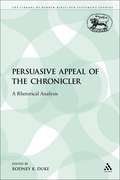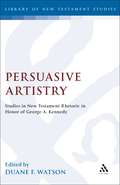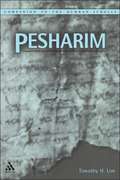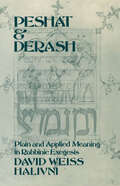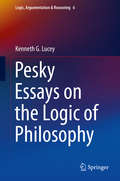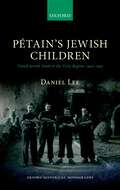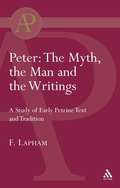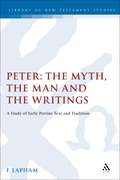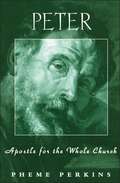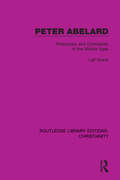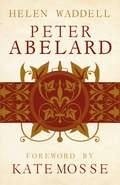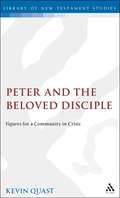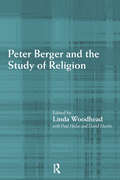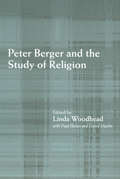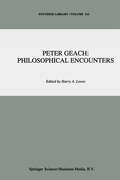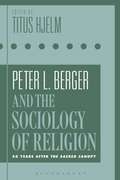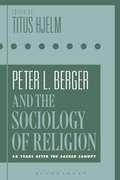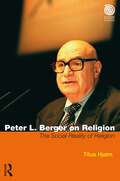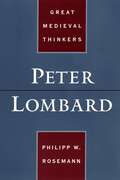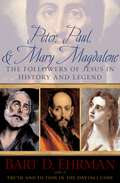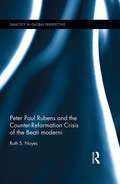- Table View
- List View
The Persuasive Appeal of the Chronicler: A Rhetorical Analysis (The Library of Hebrew Bible/Old Testament Studies)
by Rodney K. DukeDrawing on ancient rhetorical principles, this work brings a novel approach to the exploration of the literary dynamics of the books of Chronicles. Contrary to those who have viewed the Chronicler as ploddy and dull, Duke maintains that the Chronicler understood the historiographical demands of his day. Utilizing traditions, genealogical material, speeches of authoritative characters and paradigmatic portrayal of events and characters, and moving from a cautious inductive presentation of his thesis to a more propositional form of argumentation, the Chronicler retold the story of Israel with skill and artistry.
Persuasive Artistry: Studies in New Testament Rhetoric in Honor of George A. Kennedy (The Library of New Testament Studies #50)
by Duane F. WatsonCrossing diverse strains of plants often yields a hybrid more vibrant than the parent strains. The same can be said of crossing diverse branches of knowledge, as in the integration of biblical and rhetorical studies that has produced the new hybrid of interpretative rhetorical criticism. This integration is due in no small measure to the creative efforts of George A. Kennedy. In this well-integrated volume of essays in his honour, 17 scholars display the influence of the approach taken by Kennedy and others upon the interpretation of the Gospels, Acts, Romans, 2 Corinthians, Galatians, and Ephesians.
Pesharim (Companion to the Qumran Scrolls)
by Timothy LimThe Companion to the Qumran Scrolls series offers comprehensive and accessible introductions to the corpus of texts from Qumran. This volume, devoted to the characteristic biblical commentaries, discusses their contents and history, as well as their generic relationship to both New Testament and rabbinic scriptural exegesis. As with all the books in this series, this Guide is ideal for undergraduate and graduate classes.This book introduces the reader to one of the most important genres of sectarian writing from Qumran: the Pesharim, or biblical commentaries. Timothy Lim systematically discusses the textual characteristics of the quoted bible verses, the literary genre and its relationship with rabbinic midrash, the characteristics of sectarian exegesis, the nature of the historical allusions, and the common features, whether real or imagined, with the New Testament. Taking account of all relevant and recently published texts and with an annotated bibliography, this is an authoritative guide for the student or non-specialist scholar.
Peshat and Derash: Plain and Applied Meaning in Rabbinic Exegesis
by David Weiss HalivniFrom the days of Plato, the problem of the efficacy and adequacy of the written word as a vehicle of human communication has challenged mankind, yet the mystery of how best to achieve clarity and exactitude of written expression has never been solved. The most repercussive instance of this universal problem has been the exegesis of the law embodied in Hebrew scripture. Peshat and Derash is the first book to trace the Jewish interpretative enterprise from a historical perspective. Applying his vast knowledge of Rabbinic materials to the long history of Jewish exegesis of both Bible and Talmud, Halivni investigates the tension that has often existed between the plain sense of the divine text (peshat) and its creative, Rabbinic interpretations (derash). Halivni addresses the theological implications of the deviation of derash from peshat and explores the differences between the ideological extreme of the religious right, which denies that Judaism has a history, and the religious left, which claims that history is all that Judaism has. A comprehensive and critical narration of the history and repercussions of Rabbinic exegesis, this analysis will interest students of legal texts, hermeneutics, and scriptural traditions, as well as anyone involved in Jewish studies.
Pesky Essays on the Logic of Philosophy (Logic, Argumentation & Reasoning #6)
by Kenneth G. LuceyThis collection of essays explores the philosophy of human knowledge from a multitude of perspectives, with a particular emphasis upon the justification component of the classical analysis of knowledge and with an excursion along the way to explore the role of knowledge in Texas Hold ‘Em poker.An important theme of the collection is the role of knowledge in religion, including a detailed argument for agnosticism. A number of the essays touch upon issues in philosophical logic, among them a fascinating new counter-example to Modus Ponens. The collection is rounded out with essays on causality and the philosophy of mind.The author’s perspective on the philosophy of human knowledge is fresh and challenging, as evidenced by essays entitled “On Epistemic Preferability;” “On Being Unjustified;” “The Logic of ‘Unless’” and “Is ‘This sentence is true.’ True?”An interesting feature of The Logic of Philosophy: Pesky Essays is the inclusion of responses to several of its key essays, contributed by such prominent contemporary philosophers as Roderick Chisholm, Ted Sider and Tomas Kapitan.
Pétain's Jewish Children: French Jewish Youth And The Vichy Regime, 1940-1942 (Oxford Historical Monographs)
by Daniel LeePétain's Jewish Children examines the nature of the relationship between the Vichy regime and its Jewish citizens in the period 1940 to 1942. Previous studies have generally viewed the experiences of French Jewry during the Second World War through the lenses of persecution, resistance, or rescue; an approach which has had the unintended effect of stripping Jewish actors of their agency. This volume, however, draws attention to the specific category of French Jewish youth which reveals significant exceptions to Vichy's antisemitic policies, wherein the regime's desire for a reinvigorated youth and the rebirth of the nation took precedence over its racial laws. While Jews were becoming marginalised from the civil service and liberal professions, the New Order did not seek to exclude young French Jews from participating in a series of youth projects that aimed to rebuild France in the aftermath of its defeat to Germany. For example, the Jewish scouts' emphasis on manual work and a return to the land ensured that it was looked upon favourably by Vichy, who rewarded the scouts financially. Similarly, young French Jews were called up to take part in the Chantiers de la Jeunesse, Vichy's alternative to compulsory military service. In considering the roles of some of Vichy's lesser known ministers with responsibilities for youth, for whom antisemitism was not a priority, Pétain's Jewish Children illuminates the tensions between Vichy's ambition for national regeneration and its racial policies, rendering any simple account of its antisemitism misleading. While hindsight may point to the contrary, this volume shows that the emergence of the new regime did not signal the beginning of the end for French Jewry. In Vichy's first two years, while ambiguity reigned, possibilities to integrate and participate with the New Order endured and Jews were constantly presented with new avenues to probe and explore. After this point, the drastic policy changes fuelled by Prime Minister Pierre Laval and the head of Vichy Police, René Bousquet, coupled with the total occupation of France by German forces in November 1942, reduced the possibilities for coexistence almost to nothing.
Peter: The Myth, the Man and the writings
by Fred LaphamThis book critically examines all the early and important Petrine pseudepigrapha to identify a distinctive Petrine theology which, it is believed, was later swamped by the tide of western orthodoxy. Despite the diversity of the books and tractates, ranging from Jewish-Christian writings to avowedly Gnostic works, a remarkably consistent Petrine tradition does emerge; and Peter is shown essentially to be neither the impetuous, undiscerning, and even vacillating figure portrayed in the Gospels and Acts, nor the magisterial and pontifical figure of later Church tradition, but a visionary who was concerned above all to hold together both the moral and cognitive aspects of the Faith.
Peter: The Myth, the Man, and the Writings (The Library of New Testament Studies #239)
by Fred LaphamThis book critically examines all the early and important Petrine pseudepigrapha to identify a distinctive Petrine theology which, it is believed, was later swamped by the tide of western orthodoxy. Despite the diversity of the books and tractates, ranging from Jewish-Christian writings to avowedly Gnostic works, a remarkably consistent Petrine tradition does emerge; and Peter is shown essentially to be neither the impetuous, undiscerning, and even vacillating figure portrayed in the Gospels and Acts, nor the magisterial and pontifical figure of later Church tradition, but a visionary who was concerned above all to hold together both the moral and cognitive aspects of the Faith.
Peter: Apostle For The Whole Church
by Pheme PerkinsPheme Perkins searches for the historical Peter, and the influence his image has had for both Roman Catholics and Protestants. Pointing to portrayals of Peter in the Pauline and Johannine traditions, the synoptic Gospels, and the Book of Acts, Perkins argues that precisely because there is no single Petrine tradition in the New Testament, the apostle should serve as a unifying figure for many forms of Christianity. She shows how Peter should be viewed as a harmonising figure who captures the Christian imagination, not only because he is the most prominent of Jesus' disciples but also because his weaknesses and strengths reveal a character accessible to all Christians.
Peter Abelard: Philosophy and Christianity in the Middle Ages
by Leif GraneOriginally published in 1970, Peter Abelard provides an exploration into the social and religious background to the story of Abelard and Heloise. The book presents the twelfth century as an age of renaissance, which saw the revival of Greek philosophy and Roman law, a renaissance just as important as that which was to come three centuries later. Through an examination of the life of Peter Abelard, the book offers an insight into this age of enlightenment in which dialects flourished and religious thought began to break away from the bonds of traditionalism. Peter Abelard will appeal to those with an interest in religious and social history, medieval history, and the story of Abelard and Heloise.
Peter Abelard: Philosophy and Christianity in the Middle Ages
by Leif GraneOriginally published in 1970, Peter Abelard provides an exploration into the social and religious background to the story of Abelard and Heloise. The book presents the twelfth century as an age of renaissance, which saw the revival of Greek philosophy and Roman law, a renaissance just as important as that which was to come three centuries later. Through an examination of the life of Peter Abelard, the book offers an insight into this age of enlightenment in which dialects flourished and religious thought began to break away from the bonds of traditionalism. Peter Abelard will appeal to those with an interest in religious and social history, medieval history, and the story of Abelard and Heloise.
Peter Abelard
by Helen WaddellA new edition of the historical novel Peter Abelard by Helen Waddell introduced by Kate Mosse, the bestselling author of The Burning Chambers and Labyrinth.The story of Heloise and Abelard is one of the most famous love stories of all time. He was a famous philosopher in 12th Century Paris and she was a gifted scholar. He takes on the role of her tutor and the two fall passionately in love. Heloise’s Uncle arranges for them to be married in secret but his motives are far from kind. He arranges a brutal attack on Abelard which leaves him a broken man. Both Heloise and Peter take holy orders but although separated physically their love for each other lasts for the rest of their lives.First published in 1933 and a huge bestseller in its time, Helen Waddell’s novel tells their story with an intoxicating mix of drama and sensitivity and her own extensive scholarly research allows her to portray 12th France with astonishing vigour.
Peter and the Beloved Disciple: Figures for a Community in Crisis (The Library of New Testament Studies #32)
by Kevin QuastThe common supposition that the Fourth Gospel presents a rivalry between Peter and the Beloved Disciple, in which Peter is subordinated to the hero of the Johannine Community, is here subjected to fresh scrutiny. After establishing working hypotheses regarding the Johannine Community and the function of representative figures in the Fourth Gospel, the author first examines the function of Peter independently of the Beloved Disciple. Here, he is the exemplary leader of 'the Twelve'. In those passages where the two characters are juxtaposed, it is evident that the Beloved Disciple is not inordinately exalted above Peter, who in fact enjoys a comparable status. Peter and the Beloved Disciple have complementary roles to play in relation to Jesus and his unfolding 'hour'. John 20 shows the Beloved Disciple as the example of a true believing disciple of Jesus, while concerned to give appropriate respect and support to the 'Apostolic' stream of traditions associated with Peter. The Gospel appendix, ch. 21, is concerned to hold together both sorts of traditions and allegiances. Finally, the author shows how the Gospel as a whole works coherently to encourage a wider view of Christian 'intercommunity' unity after the death of the Beloved Disciple.
Peter Berger and the Study of Religion
by Paul Heelas David Martin Linda WoodheadPeter Berger is the most influential contemporary sociologist of religion. This collection of essays is the first in-depth study of his contribution to the field, providing a comprehensive introduction to his work and to current thought in the study of religion. Themes addressed include: * Berger on religion and theology* Religion, spirituality and the discontents of modernity* Secularization and de-secularizationA postscript by Peter Berger, responding to the essays, completes this overview of this major figure's work.
Peter Berger and the Study of Religion
by Paul Heelas David Martin Linda WoodheadPeter Berger is the most influential contemporary sociologist of religion. This collection of essays is the first in-depth study of his contribution to the field, providing a comprehensive introduction to his work and to current thought in the study of religion. Themes addressed include: * Berger on religion and theology* Religion, spirituality and the discontents of modernity* Secularization and de-secularizationA postscript by Peter Berger, responding to the essays, completes this overview of this major figure's work.
Peter Geach: Philosophical Encounters (Synthese Library #213)
by H. A. LewisThe present volume owes its existence to a proposal of Dr Esa Saarinen. Our aim was to celebrate the work of a living philosopher by presenting it both from his own point of view, through the medium of a philosophical autobiography, and from that of his closest philo sophical colleagues and adversaries. We felt that a philosophical career lived through vigorous controversy was best reflected not by adulation but in the spirit of that career - by open debate. Contributors were not constrained in their choice of topic, but their contributions fell naturally into groups linked with some of Peter Geach's principal areas of interest, and we have so grouped them in the book. There is an interweaving of biographical and philosophical themes, not only in Peter Geach's philosophical autobiography, but also in the introductions he has contributed to each section. Professor W. V. O. Quine's contribution, which consists of extracts from his correspondence with Peter Geach, has been set apart as it forms a natural bridge between Peter Geach's autobiography and the contri butions that follow. Their correspondence reproduced here throws new light on many familiar themes from the writings of both philosophers: among them, the objects of belief and other attitudes, issues in set theory, the nature of causality, and evolution in epistemology.
Peter L. Berger and the Sociology of Religion: 50 Years after The Sacred Canopy
by Titus HjelmHow and why did The Sacred Canopy by Peter L. Berger (1929–2017) become a classic? How have scholars used Berger's ideas over the past 50 years since its publication? How are these ideas relevant to the future of the sociology of religion? Peter L. Berger and the Sociology of Religion explores these questions by providing a broad overview of Berger's work, as well as more focussed studies. The chapters discuss both aspects of Berger's classic text: the 'systematic' sociological theorising on religion and the 'historical' theorising on secularisation. The articles also critically examine Berger's reversal regarding secularisation and the suggested 'desecularisation' of the world. The approaches range from disciplinary history to applications of Berger's ideas. The book includes contributions from Nancy Ammerman, Steve Bruce, David Feltmate, Effie Fokas, Titus Hjelm, D. Paul Johnson, Hubert Knoblauch, Silke Steets, Riyaz Timol, and Bryan S. Turner.
Peter L. Berger and the Sociology of Religion: 50 Years after The Sacred Canopy
by Titus HjelmHow and why did The Sacred Canopy by Peter L. Berger (1929–2017) become a classic? How have scholars used Berger's ideas over the past 50 years since its publication? How are these ideas relevant to the future of the sociology of religion? Peter L. Berger and the Sociology of Religion explores these questions by providing a broad overview of Berger's work, as well as more focussed studies. The chapters discuss both aspects of Berger's classic text: the 'systematic' sociological theorising on religion and the 'historical' theorising on secularisation. The articles also critically examine Berger's reversal regarding secularisation and the suggested 'desecularisation' of the world. The approaches range from disciplinary history to applications of Berger's ideas. The book includes contributions from Nancy Ammerman, Steve Bruce, David Feltmate, Effie Fokas, Titus Hjelm, D. Paul Johnson, Hubert Knoblauch, Silke Steets, Riyaz Timol, and Bryan S. Turner.
Peter L. Berger on Religion: The Social Reality of Religion (Key Thinkers in the Study of Religion)
by Titus HjelmPeter L. Berger on Religion provides an overview and critical assessment of the work of one of the most influential sociologists of the 20th century.Situating Berger’s writings on religion and secularisation in the broader framework of social constructionism, the book argues that neither he nor the research influenced by him consistently followed the constructionist paradigm. This assessment is informed by a close examination of The Sacred Canopy (1967), in particular. The volume also offers a Berger‑inspired constructionist framework for the study of religion.This book is an excellent resource for students and researchers interested in the intersection of religion and social theory.
Peter L. Berger on Religion: The Social Reality of Religion (Key Thinkers in the Study of Religion)
by Titus HjelmPeter L. Berger on Religion provides an overview and critical assessment of the work of one of the most influential sociologists of the 20th century.Situating Berger’s writings on religion and secularisation in the broader framework of social constructionism, the book argues that neither he nor the research influenced by him consistently followed the constructionist paradigm. This assessment is informed by a close examination of The Sacred Canopy (1967), in particular. The volume also offers a Berger‑inspired constructionist framework for the study of religion.This book is an excellent resource for students and researchers interested in the intersection of religion and social theory.
Peter Lombard (Great Medieval Thinkers)
by Philipp W. RosemannPeter Lombard is best known as the author of a celebrated work entitled Book of Sentences, which for several centuries served as the standard theological textbook in the Christian West. It was the subject of more commentaries than any other work of Christian literature besides the Bible itself. The Book of Sentences is essentially a compilation of older sources, from the Scriptures and Augustine down to several of the Lombard's contemporaries, such as Hugh of Saint Victor and Peter Abelard. Its importance lies in the Lombard's organization of the theological material, his method of presentation, and the way in which he shaped doctrine in several major areas. Despite his importance, however, there is no accessible introduction to Peter Lombard's life and thought available in any modern language. This volume fills this considerable gap. Philipp W. Rosemann begins by demonstrating how the Book of Sentences grew out of a long tradition of Christian reflection-a tradition, ultimately rooted in Scripture, which by the twelfth century had become ready to transform itself into a theological system. Turning to the Sentences, Rosemann then offers a brief exposition of the Lombard's life and work. He proceeds to a book-by-book examination and interpretation of its main topics, including the nature and attributes of God, the Trinity, creation, angelology, human nature and the Fall, original sin, Christology, ethics, and the sacraments. He concludes by exploring how the Sentences helped shape the further development of the Christian tradition, from the twelfth century through the time of Martin Luther.
Peter Lombard: Volume 3 (Great Medieval Thinkers)
by Philipp W. RosemannPeter Lombard is best known as the author of a celebrated work entitled Book of Sentences, which for several centuries served as the standard theological textbook in the Christian West. It was the subject of more commentaries than any other work of Christian literature besides the Bible itself. The Book of Sentences is essentially a compilation of older sources, from the Scriptures and Augustine down to several of the Lombard's contemporaries, such as Hugh of Saint Victor and Peter Abelard. Its importance lies in the Lombard's organization of the theological material, his method of presentation, and the way in which he shaped doctrine in several major areas. Despite his importance, however, there is no accessible introduction to Peter Lombard's life and thought available in any modern language. This volume fills this considerable gap. Philipp W. Rosemann begins by demonstrating how the Book of Sentences grew out of a long tradition of Christian reflection-a tradition, ultimately rooted in Scripture, which by the twelfth century had become ready to transform itself into a theological system. Turning to the Sentences, Rosemann then offers a brief exposition of the Lombard's life and work. He proceeds to a book-by-book examination and interpretation of its main topics, including the nature and attributes of God, the Trinity, creation, angelology, human nature and the Fall, original sin, Christology, ethics, and the sacraments. He concludes by exploring how the Sentences helped shape the further development of the Christian tradition, from the twelfth century through the time of Martin Luther.
Peter, Paul and Mary Magdalene: The Followers of Jesus in History and Legend
by Bart D EhrmanBart Ehrman, author of the highly popular books Truth and Fiction in The Da Vinci Code, Lost Christianities, and the New York Times bestseller Misquoting Jesus, here takes readers on another engaging tour of the early Christian church, illuminating the lives of Jesus' most intriguing followers: Simon Peter, the Apostle Paul, and Mary Magdalene. What does the Bible tell us about each of these key followers of Christ? What legends have sprung up about them in the centuries after their deaths? Was Paul bow-legged and bald? Was Peter crucified upside down? Was Mary Magdalene a prostitute? In this lively work, Ehrman separates fact from fiction, presenting complicated historical issues in a clear and informative way and relating vivid anecdotes culled from the traditions of these three followers. He notes, for instance, that there is no evidence to suggest that Mary Magdalene was a prostitute (this legend can be traced to a sermon preached by Gregory the Great five centuries after her death), and little reason to think that she was married to Jesus. Similarly, there is no historical evidence for the well-known tale that Peter was crucified upside down. A serious book but vibrantly written and leavened with many colorful stories, Peter, Paul, and Mary Magdalene will appeal to anyone curious about the early Christian church and the lives of these important figures. "An informed but breezy look at the myths surrounding Jesus' most influential followers.... This book contains valuable historical scholarship. It also encourages readers to approach the Scriptures with fresh and enlightened eyes." --Christian Science Monitor
Peter, Paul and Mary Magdalene: The Followers of Jesus in History and Legend
by Bart D EhrmanBart Ehrman, author of the highly popular books Truth and Fiction in The Da Vinci Code, Lost Christianities, and the New York Times bestseller Misquoting Jesus, here takes readers on another engaging tour of the early Christian church, illuminating the lives of Jesus' most intriguing followers: Simon Peter, the Apostle Paul, and Mary Magdalene. What does the Bible tell us about each of these key followers of Christ? What legends have sprung up about them in the centuries after their deaths? Was Paul bow-legged and bald? Was Peter crucified upside down? Was Mary Magdalene a prostitute? In this lively work, Ehrman separates fact from fiction, presenting complicated historical issues in a clear and informative way and relating vivid anecdotes culled from the traditions of these three followers. He notes, for instance, that there is no evidence to suggest that Mary Magdalene was a prostitute (this legend can be traced to a sermon preached by Gregory the Great five centuries after her death), and little reason to think that she was married to Jesus. Similarly, there is no historical evidence for the well-known tale that Peter was crucified upside down. A serious book but vibrantly written and leavened with many colorful stories, Peter, Paul, and Mary Magdalene will appeal to anyone curious about the early Christian church and the lives of these important figures. "An informed but breezy look at the myths surrounding Jesus' most influential followers.... This book contains valuable historical scholarship. It also encourages readers to approach the Scriptures with fresh and enlightened eyes." --Christian Science Monitor
Peter Paul Rubens and the Counter-Reformation Crisis of the Beati moderni (Sanctity in Global Perspective)
by Ruth S. NoyesPeter Paul Rubens and the Crisis of the Beati Moderni takes up the question of the issues involved in the formation of recent saints - or Beati moderni (modern Blesseds) as they were called - by the Jesuits and Oratorians in the new environment of increased strictures and censorship that developed after the Council of Trent with respect to legal canonization procedures and cultic devotion to the saints. Ruth Noyes focuses particularly on how the new regulations pertained to the creation of emerging cults of those not yet canonized, the so-called Beati moderni, such as Jesuit founders Francis Xavier and Ignatius Loyola, and Filippo Neri, founder of the Oratorians. Centrally involved in the book is the question of the fate and meaning of the two altarpiece paintings commissioned by the Oratorians from Peter Paul Rubens. The Congregation rejected his first altarpiece because it too specifically identified Filippo Neri as a cult figure to be venerated (before his actual canonization) and thus was caught up in the politics of cult formation and the papacy’s desire to control such pre-canonization cults. The book demonstrates that Rubens' second altarpiece, although less overtly depicting Neri as a saint, was if anything more radical in the claims it made for him. Peter Paul Rubens and the Crisis of the Beati Moderni offers the first comparative study of Jesuit and Oratorian images of their respective would-be saints, and the controversy they ignited across Church hierarchies. It is also the first work to examine provocative Philippine imagery and demonstrate how its bold promotion specifically triggered the first wave of curial censure in 1602.
